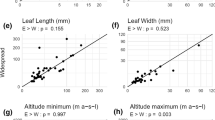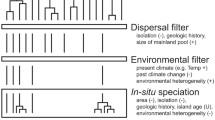Abstract
Animals often evolve conspicuous differences in body size after colonising isolated islands. However, far less is known about repeated patterns in the evolution of plant size on islands. We tested for convergent evolution of leaf area, seed size and plant stature in the flora of the Chatham Islands (i.e. Rēkohu), which are located 700 km off the east coast of New Zealand. First, we measured leaf area, seed size and plant stature from populations of 22 plant taxa on the Chatham Islands. These data were then compared to analogous measurements from their sister taxa on the mainland to test for evidence of island gigantism, and whether size changes differ between leaves, seeds and stature. Second, we collated data from the literature to test whether size changes in endemic taxa differed among plant growth forms or were correlated with divergence times. Results showed that all three plant traits tended to increase in size on the Chatham Islands. However, field data showed that size increases tended to be more consistent in seeds and leaves than in stature. Data from the literature indicated that size increases also differed among growth forms. Herbaceous species showed the strongest evidence of gigantism, followed by woody plants, while graminoids showed a weak trend towards dwarfism. Insular size increases in seeds and leaves were also positively related to divergence times, indicating that taxa which have resided on the Chatham Islands for longer periods show stronger evidence of gigantism than taxa which arrived more recently. Overall results illustrate that gigantism is a hallmark of the Chatham Island flora, providing a remarkable example of convergent evolution.



Similar content being viewed by others
References
Allan HH (1982) Flora of New Zealand: indigenous tracheophyta: psilopsida, lycopsida, filocopsida, gymnospermae, dicotyledones. PD. Hasselberg Government Printer, Wellington
Bayly MJ, Kellow AV (2006) An illustrated guide to New Zealand hebes. Te Papa press, Wellington
Beever RE (1986) Large-leaved plants of northern offshore islands, New Zealand. In: Wright AE, Beever RE (eds) The offshore islands of northern New Zealand. New Zealand Department of Lands and Survey Information Series vol 16, pp 51–61
Benton MJ, Csiki Z, Grigorescu D, Redelstorff R, Sander PM, Stein K, Weishampel DB (2010) Dinosaurs and the island rule: the dwarfed dinosaurs from Haţeg Island. Palaeogeogr Palaeoclimatol Palaeoecol 293:438–454
Bromham L, Cardillo M (2007) Primates follow the ‘island rule’: implications for interpreting Homo floresiensis. Biol Let 3:398–400
Burns KC (2014) Are there general patterns in plant defence against megaherbivores? Biol J Linn Soc Lond 111:38–48. doi:10.1111/bij.12181
Burns KC (2016) Size changes in island plants: independent trait evolution in Alyxia ruscifolia (Apocynaceae) on Lord Howe Island. Biol J Linn Soc 119:847–855
Burns KC, Dawson JW (2009) Heteroblasty on Chatham Island: a comparison with New Zealand and New Caledonia. N Z J Ecol 33:156–163
Burns KC, Herold N, Wallace B (2012) Evolutionary size changes in plants of the south–west Pacific. Glob Ecol Biogeogr 21:819–828. doi:10.1111/j.1466-8238.2011.00730.x
Carlquist S (1974) Island biology. Columbia University Press, New York
Carlquist S (1980) Hawaii: a natural history. Geology, climate, native flora and fauna above the shoreline (vol 6). SB Printers, Inc. for Pacific Tropical Botanical Garden (xii), Honolulu, USA
Cheeseman TF (1906) Manual of the New Zealand flora. J. Mackay Government Printer, Wellington
Clark L, Burns KC (2016) Spinescence in the New Zealand flora: parallels with Australia. N Z J Bot 54:273–289
Curtis W (1963) Student’s flora of Tasmania. LG. Shea Government Printer, Tasmania
Cody ML, Overton J (1996) Short-term evolution of reduced dispersal in island plant populations. J Ecol 84:53–61
Cox CB, Moore PD, Marquardt WC, Demaree RS, Grieve RB (2005) Biogeography: an ecological and evolutionary approach, 6th edn. Blackwell Publishing, New York
Darwin C (1859) On the origin of species by means of natural selection. J. Murray, London
Dawson J (1988) Forest vines to snow tussocks: the story of New Zealand plants. Victoria University of Wellington Press, Wellington
Dawson J, Lucas R, Connor J, Brownsey PJ (2011) New Zealand’s native trees. Craig Potton, Nelson
De Lange PJ, Heenan PB, Norton DA, Rolfe JR, Sawyer J (2010) Threatened plants of New Zealand. Canterbury University Press, Christchurch
Eagle A (2006) Eagle’s complete trees and shrubs of New Zealand, vol 2. Te Papa Press, Wellington
Edgar E, Connor HE (2000) Flora of New Zealand-Vol. V: Gramineae (No. Ed. 2). Manaaki Whenua Press, Landcare Research, Lincoln, Canturbury
Edwards PJ, Fleischer-Dogley F, Kaiser-Bunbury CN (2015) The nutrient economy of Lodoicea maldivica, a monodominant palm producing the world’s largest seed. New Phytol 206:990–999
Fadzly N, Jack C, Schaefer HM, Burns KC (2009) Ontogenetic colour changes in an insular tree species: signalling to extinct browsing birds? New Phytol 184:495–501
Given DR, Williams PA (1984) Conservation of Chatham Island flora and vegetation. Botany Division, Department of Scientific and Industrial Research
Gómez JM (2004) Bigger is not always better: conflicting selective pressures on seed size in Quercus ilex. Evolution 58:71–80
Green PS (1994) Flora of Australia (Vol. 49): Oceanic Islands. Australian Biological Resources Study and CSIRO Publishing, Canberra
Hanley ME, Lamont BB, Fairbanks MM, Rafferty CM (2007) Plant structural traits and their role in anti-herbivore defence. Perspect Plant Ecol Evol Syst 8:157–178
Healy AJ, Edgar E (1980) Flora of New Zealand: adventive cyperaceous, petalous and spathaceous monocotyledons, vol 3. PD. Hasselberg, Government, Wellington
Heenan PB, Mitchell AD, de Lange PJ, Keeling J, Paterson AM (2010) Late Cenozoic origin and diversification of Chatham Islands endemic plant species revealed by analyses of DNA sequence data. N Z J Bot 48:83–136
Hochberg MC (1980) Factors affecting leaf size of chaparral shrubs on the California islands. In: Power DM (ed) The California Islands. Santa Barbara Museum of Natural History, Santa Barbara, California, pp 189–206
Jaffe AL, Slater GJ, Alfaro ME (2011) The evolution of island gigantism and body size variation in tortoises and turtles. Biol Let 7:558–561. doi:10.1098/rsbl.2010.1084
Kavanagh PH (2015) Herbivory and the evolution of divaricate plants: structural defences lost on an offshore island. Austral Ecol 40:206–211
Kavanagh PH, Burns KC (2014) The repeated evolution of large seeds on islands. Proc R Soc Lond B 281:20140675
Leishman MR (2001) Does the seed size/number trade-off model determine plant community structure? an assessment of the model mechanisms and their generality. Oikos 93:294–302
Lens F, Davin N, Smets E, del Arco M (2013) Insular woodiness on the Canary Islands: a remarkable case of convergent evolution. Int J Plant Sci 174:992–1013
Little L, Eidesen PB, Müller E, Dickinson KJ, Lord JM (2016) Leaf and floral heating in cold climates: do sub-Antarctic megaherbs resemble tropical alpine giants? Polar Res 35(1):26030. doi:10.3402/polar.v35.26030
Lomolino MV, Dax DF, Riddle BR, Brown JH (2006) The island rule and a research agenda for studying ecogeographical patterns. J Biogeogr 33:1503–1510
Lomolino MV, van der Geer AA, Lyras GA, Palombo MR, Sax DF, Rozzi R (2013) Of mice and mammoths: generality and antiquity of the island rule. J Biogeogr J Biogeogr 40:1427–1439. doi:10.1111/jbi.12096
Lord JM (2015) Patterns in plant traits and breeding systems on Southern Ocean islands. AoB Plants 7:plv095. doi:10.1093/aobpla/plv095
McNab BK (2010) Geographic and temporal correlations of mammalian size reconsidered: a resource rule. Oecologia 164:13–32
Meiri S, Dayan T, Simberloff D (2006) The generality of the island rule reexamined. J Biogeogr 33:1571–1577
Meiri S, Cooper N, Purvis A (2008) The island rule: made to be broken? Proc R Soc B Biol Sci 275:141–148
Meiri S, Dayan T, Simberloff D, Grenyer R (2009) Life on the edge: carnivore body size variation is all over the place. Proc R S B Biol Sci 276:1469–1476
Moles AT, Warton DI, Westoby M (2003) Do small-seeded species have higher survival through seed predation than large-seeded species? Ecology 84:3148–3161
Montesinos R, Silva HR, Carvalho ALG (2012) The ‘island rule’acting on anuran populations (Bufonidae: Rhinella ornata) of the Southern Hemisphere. Biotropica 44:506–511
Olson SL, Hearty PJ (2010) Predation as the primary selective force in recurrent evolution of gigantism in Poecilozonites land snails in Quaternary Bermuda. Biol Lett 6:807–810. doi:10.1098/rsbl.2010.0423
Patiño J, Bisang I, Hedenäs L, Dirkse G, Bjarnason AH, Ah-Peng C, Vanderpoorten A (2013) Baker’s law and the island syndromes in bryophytes. J Ecol 101:1245–1255
Poole AL, Adams NM (1980) Trees and shrubs of New Zealand. PD. Hasselberg, Governement Printer, Wellington
R Core Team (2014) R: a language and environment for statistical computing. R Foundation for Statistical Computing, Vienna, Austria. http://www.R-project.org/
Reader RJ (1993) Control of seedling emergence by ground cover and seed predation in relation to seed size for some old-field species. J Ecol 81:169–175
Stilwell JD (1997) Tectonic and palaeobiogeographic significance of the Chatham Islands, South Pacific, late Cretaceous fauna. Palaeogeogr Palaeoclimatol Palaeoecol 136:97–119
van der Geer A, Lyras G, De Vos J, Dermitzakis M (2011) Evolution of island mammals: adaptation and extinction of placental mammals on islands. Wiley, Oxford
Wagstaff SJ, Breitwieser I, Ito M (2011) Evolution and biogeography of Pleurophyllum (Astereae, Asteraceae), a small genus of megaherbs endemic to the subantarctic islands. Am J Bot 98:62–75
Walters SM (1984) The European garden flora: a manual for the identification of plants cultivated in Europe, both out-of-doors and under glass, vol 6. Cambridge University Press, Cambridge
Webb CJ, Simpson MJ (2001) Seeds of New Zealand gymnosperms and dicotyledons. Manuka Press, Christchurch
Weigelt P, Jetz W, Kreft H (2013) Bioclimatic and physical characterization of the world’s Islands. Proc Natl Acad Sci 110:15307–15312
Wilson CM, Given DR (1989) Threatened plants of New Zealand: DSIR Field Guide. DSIR Publishing, Wellington
Acknowledgements
We would like to thank Maui Solomon and Susan Thorpe from Hokotehi Moriori Trust and Patrick Kavanagh for assistance in the field. *Data not listed in Table 1 will be made publically available upon publication.
Author information
Authors and Affiliations
Corresponding author
Electronic supplementary material
Below is the link to the electronic supplementary material.
Rights and permissions
About this article
Cite this article
Cox, B.T.M., Burns, K.C. Convergent evolution of gigantism in the flora of an isolated archipelago. Evol Ecol 31, 741–752 (2017). https://doi.org/10.1007/s10682-017-9909-0
Received:
Accepted:
Published:
Issue Date:
DOI: https://doi.org/10.1007/s10682-017-9909-0




